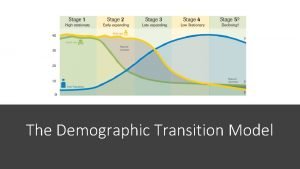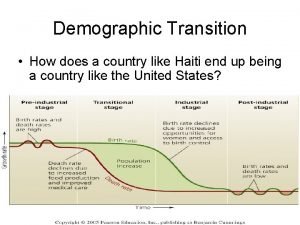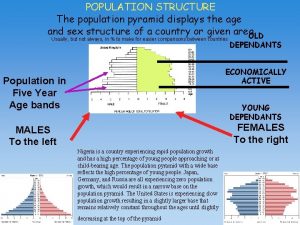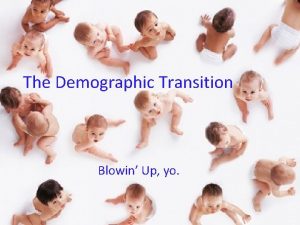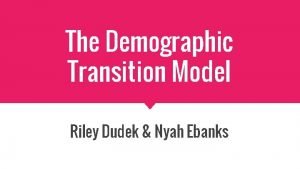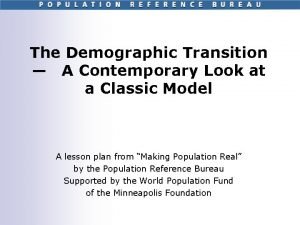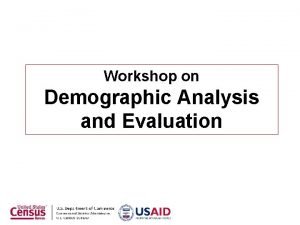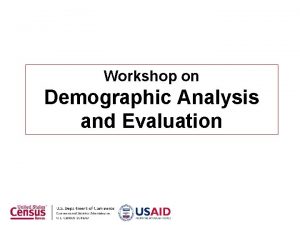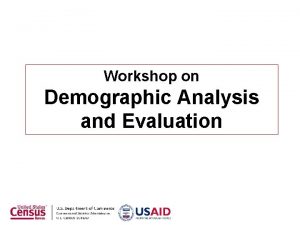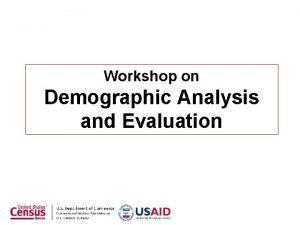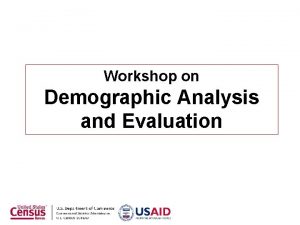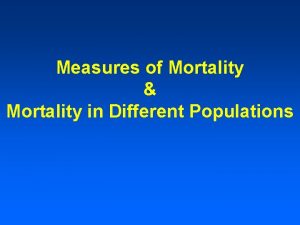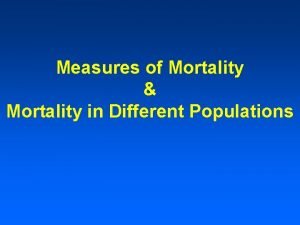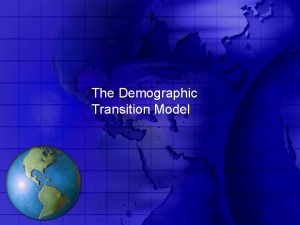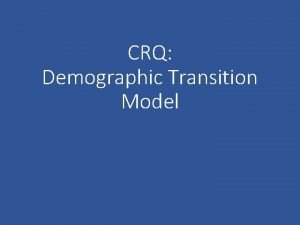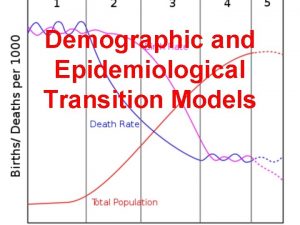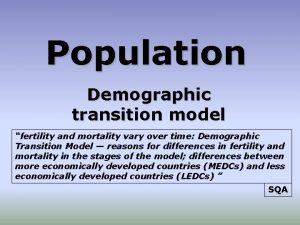Workshop on Demographic Analysis and Evaluation Mortality Model
















- Slides: 16

Workshop on Demographic Analysis and Evaluation

Mortality: Model Life Tables

Model Life Tables In this part of the workshop we will discuss: The logic and use of model life tables Software for constructing model life tables 3

Model Life Tables Model life tables have been constructed during the past six decades principally from historical experience indicating that the pattern of mortality by age is highly predictable. Thus, model life tables are constructed using mathematical procedures and mortality patterns observed in life tables pertaining to actual populations with reliable data. Model life tables are frequently used in demographic analysis for two main purposes: to estimate a probable current mortality level and to project the mortality pattern to some future date. 4

Model Life Tables Model life table functions are strongly related by age. Thus, if values for some of the functions are available, the rest can be estimated with some degree of certainty using model life tables. For example, if estimates of mortality are available for some ages, estimates for other ages can be interpolated using model life tables. 5

Model Life Tables If values for all of the functions are available, but contain severe problems, they can be adjusted using model life tables. For example, if mortality rates for an actual population are severely distorted because of errors in the deaths data, these rates can be smoothed using models. 6

Model Life Tables Model life tables can even be used to estimate a possible level of life expectancy at birth based on an estimated infant mortality rate; or conversely, a level of infant mortality can be estimated from an estimate of the life expectancy at birth. Spreadsheet: MATCH. xls or MATCH_BS. xls 7

The Earliest Model Life Tables The first models were developed by the United Nations (1956) based on empirical life tables available for various developed countries at that time. These models were constructed by calculating correlations between probabilities of dying pertaining to two consecutive age groups. Starting with an arbitrary level of infant mortality, the rest of the probabilities of dying were obtained using the estimated regression equations. 8

The Coale-Demeny Regional Model Life Tables A set of model life tables was then developed by Coale and Demeny (1968). These models use more information than the early United Nations models and classify the life tables into four different sets, labeled West, East, North, and South, according to the patterns of mortality in the predominant regions of Europe represented in the original data. In each of these sets, the life expectancy at age 10 was correlated with the probability of dying at different ages, and these correlations provided the basis for estimating a series of “nested” life tables at different overall levels of e(x) but with different mortality patterns. 9

The Coale-Demeny Regional Model Life Tables In addition to the life tables, corresponding stable populations – populations that would occur if mortality and fertility were unchanging and the populations themselves were closed to migration -- were derived, based on the model life tables and age-specific fertility rates for various levels of the total fertility rate. 10

Coale-Demeny MLTs Were Created to Mirror Observed Variation in Empirical Life Tables 11

Coale-Demeny MLT Patterns Are Maintained as Mortality Level Varies from 50 to 80 Years 12

Brass' General Standard and African Standard At about the same time as the Coale-Demeny models appeared, Brass (Brass et al. , 1968) developed the General Standard Model. In this model, life tables are related by a two-parameter logit system, based on a general pattern of mortality and a linear relationship between two sets of logits. By changing the two parameters of the linear relationship, the general pattern is changed in relation to the level and pattern of mortality. Brass also introduced his African Standard in the same book. The African Standard differs from the General Standard by its relatively high childhood mortality vis a vis infant mortality (Brass et al. , 1968: 113). 13

The (New) United Nations Model Life Tables Most of the empirical life tables used in constructing the models described above pertained to developed countries. In the 1980 s, the United Nations published a new set of life table models, based on the mortality experience of developing countries with reliable information (Heligman, 1984 and United Nations, 1982). Empirical life tables for developing countries were grouped into four sets, plus a general set including all of them. These sets refer to the Latin American, Chilean, South Asian, Far Eastern, and General patterns. 14

United Nations and Coale-Demeny West MLT Patterns Compared, Females at e(0) = 60 & 70 Years 15

Other Model Life Tables Other less frequently used model life tables are the Ledermann (1969) and the OECD (Organization for Economic Cooperation and Development) (1980) models. 16
 Carrying capacity ap human geography
Carrying capacity ap human geography Uk demographic transition model
Uk demographic transition model Dtm model
Dtm model Demographic transition model ap human geography
Demographic transition model ap human geography Chile demographic transition model
Chile demographic transition model Warren thompson's demographic transition model
Warren thompson's demographic transition model Haiti demographic transition model
Haiti demographic transition model Demographic transition mode
Demographic transition mode Hotelling model ap human geography
Hotelling model ap human geography Demographic transition model population pyramids
Demographic transition model population pyramids Demographic transition model worksheet
Demographic transition model worksheet Demographic transition model song
Demographic transition model song Demographic transition model uk
Demographic transition model uk Afghanistan demographic transition model
Afghanistan demographic transition model Demographic transition model example
Demographic transition model example Demographic transition model
Demographic transition model Morbidity and mortality
Morbidity and mortality

